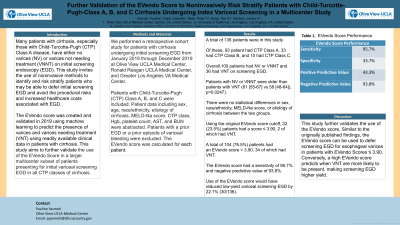Back


Poster Session C - Monday Afternoon
Category: Liver
C0487 - Further Validation of the EVendo Score to Noninvasively Risk Stratify Patients With Child-Turcotte-Pugh Class A, B, and C Cirrhosis Undergoing Index Variceal Screening in a Multicenter Study
Monday, October 24, 2022
3:00 PM – 5:00 PM ET
Location: Crown Ballroom

Has Audio

Pauline Yasmeh, MD
UCLA Olive View Medical Center
Los Angeles, CA
Presenting Author(s)
Pauline Yasmeh, MD1, Camellia Dalai, MD2, Peter Beah, MD3, Tien Dong, MD, PhD4, James Tabibian, MD, PhD5
1UCLA Olive View Medical Center, Los Angeles, CA; 2University of New Mexico, Los Angeles, CA; 3University of California Los Angeles Medical Center, Los Angeles, CA; 4Greater Los Angeles Veterans Affairs, Los Angeles, CA; 5Olive View-UCLA Medical Center, Sylmar, CA
Introduction: Many patients with cirrhosis, especially those with Child-Turcotte-Pugh (CTP) Class A disease, have either no varices (NV) or varices not needing treatment (VNNT) on initial screening endoscopy (EGD). This study invites the use of noninvasive methods to identify and risk stratify patients who may be able to defer initial screening EGD and avoid the procedural risks and increased healthcare costs associated with EGD. The EVendo score was created and validated in 2019 using machine learning to predict the presence of varices and varices needing treatment (VNT) using readily available clinical data in patients with cirrhosis. This study aims to further validate the use of the EVendo Score in a larger multicenter subset of patients presenting for initial variceal screening EGD in all CTP classes of cirrhosis.
Methods: We performed a retrospective cohort study for patients with cirrhosis undergoing initial screening EGD from January 2019 through December 2019 at Olive View UCLA Medical Center, Ronald Reagan UCLA Medical Center, and Greater Los Angeles VA Medical Center. Patient data including sex, age, race/ethnicity, etiology of cirrhosis, MELD-Na score, CTP class, Hgb, platelet count, AST, and BUN were abstracted. Patients with a prior EGD or a prior episode of variceal bleeding were excluded. The EVendo score was calculated for each patient.
Results: A total of 136 patients were included in the study. Of these patients, 93 had CTP Class A, 33 had CTP Class B, and 10 had CTP Class C. Overall,100 patients had NV or VNNT and 36 had VNT on screening EGD. Patients with NV or VNNT were older than patients with VNT (61 [55-67] vs 58 [48-64]), p=0.0247). There were no statistical differences in sex, race/ethnicity, MELD-Na score, or etiology of cirrhosis between the two groups. Using the original EVendo score cutoff, 32 (23.5%) patients had a score ≤ 3.90, 2 of which had VNT. A total of 104 (76.5%) patients had an EVendo score > 3.90, 34 of which had VNT. The EVendo score had a sensitivity of 95.7% and negative predictive value of 93.8% (Table 1). Use of the EVendo score would have reduced low-yield variceal screening EGD by 22.1% (30/136).
Discussion: This study further validates the use of the EVendo score. Similar to the originally published findings, the EVendo score can be used to defer screening EGD for esophageal varices in patients with EVendo Scores ≤ 3.90. Conversely, a high EVendo score predicts when VNT are more likely to be present, making screening EGD higher yield.
Disclosures:
Pauline Yasmeh, MD1, Camellia Dalai, MD2, Peter Beah, MD3, Tien Dong, MD, PhD4, James Tabibian, MD, PhD5. C0487 - Further Validation of the EVendo Score to Noninvasively Risk Stratify Patients With Child-Turcotte-Pugh Class A, B, and C Cirrhosis Undergoing Index Variceal Screening in a Multicenter Study, ACG 2022 Annual Scientific Meeting Abstracts. Charlotte, NC: American College of Gastroenterology.
1UCLA Olive View Medical Center, Los Angeles, CA; 2University of New Mexico, Los Angeles, CA; 3University of California Los Angeles Medical Center, Los Angeles, CA; 4Greater Los Angeles Veterans Affairs, Los Angeles, CA; 5Olive View-UCLA Medical Center, Sylmar, CA
Introduction: Many patients with cirrhosis, especially those with Child-Turcotte-Pugh (CTP) Class A disease, have either no varices (NV) or varices not needing treatment (VNNT) on initial screening endoscopy (EGD). This study invites the use of noninvasive methods to identify and risk stratify patients who may be able to defer initial screening EGD and avoid the procedural risks and increased healthcare costs associated with EGD. The EVendo score was created and validated in 2019 using machine learning to predict the presence of varices and varices needing treatment (VNT) using readily available clinical data in patients with cirrhosis. This study aims to further validate the use of the EVendo Score in a larger multicenter subset of patients presenting for initial variceal screening EGD in all CTP classes of cirrhosis.
Methods: We performed a retrospective cohort study for patients with cirrhosis undergoing initial screening EGD from January 2019 through December 2019 at Olive View UCLA Medical Center, Ronald Reagan UCLA Medical Center, and Greater Los Angeles VA Medical Center. Patient data including sex, age, race/ethnicity, etiology of cirrhosis, MELD-Na score, CTP class, Hgb, platelet count, AST, and BUN were abstracted. Patients with a prior EGD or a prior episode of variceal bleeding were excluded. The EVendo score was calculated for each patient.
Results: A total of 136 patients were included in the study. Of these patients, 93 had CTP Class A, 33 had CTP Class B, and 10 had CTP Class C. Overall,100 patients had NV or VNNT and 36 had VNT on screening EGD. Patients with NV or VNNT were older than patients with VNT (61 [55-67] vs 58 [48-64]), p=0.0247). There were no statistical differences in sex, race/ethnicity, MELD-Na score, or etiology of cirrhosis between the two groups. Using the original EVendo score cutoff, 32 (23.5%) patients had a score ≤ 3.90, 2 of which had VNT. A total of 104 (76.5%) patients had an EVendo score > 3.90, 34 of which had VNT. The EVendo score had a sensitivity of 95.7% and negative predictive value of 93.8% (Table 1). Use of the EVendo score would have reduced low-yield variceal screening EGD by 22.1% (30/136).
Discussion: This study further validates the use of the EVendo score. Similar to the originally published findings, the EVendo score can be used to defer screening EGD for esophageal varices in patients with EVendo Scores ≤ 3.90. Conversely, a high EVendo score predicts when VNT are more likely to be present, making screening EGD higher yield.
Sensitivity | 95.7% |
Specificity | 33.7% |
Positive Predictive Value | 43.3% |
Negative Predictive Value | 93.8% |
Table: Table 1. EVendo Score Performance
Disclosures:
Pauline Yasmeh indicated no relevant financial relationships.
Camellia Dalai indicated no relevant financial relationships.
Peter Beah indicated no relevant financial relationships.
Tien Dong indicated no relevant financial relationships.
James Tabibian: Olympus Corporation – Consultant.
Pauline Yasmeh, MD1, Camellia Dalai, MD2, Peter Beah, MD3, Tien Dong, MD, PhD4, James Tabibian, MD, PhD5. C0487 - Further Validation of the EVendo Score to Noninvasively Risk Stratify Patients With Child-Turcotte-Pugh Class A, B, and C Cirrhosis Undergoing Index Variceal Screening in a Multicenter Study, ACG 2022 Annual Scientific Meeting Abstracts. Charlotte, NC: American College of Gastroenterology.

